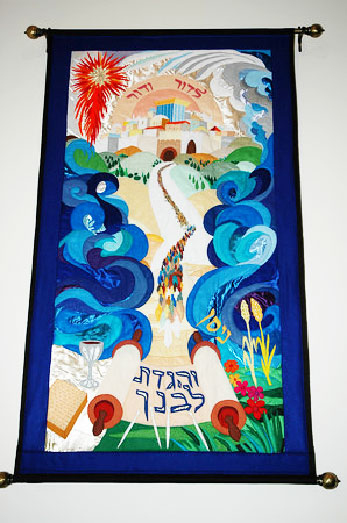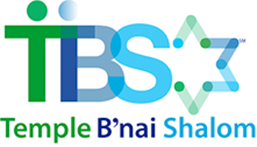Tapestry #7: Nisan- “Passing On and Passing Over”
 Passover and the Jewish Values of L’dor Vador (From Generation to Generation and V’higadita l’vincha (And you shall tell your child…)
Passover and the Jewish Values of L’dor Vador (From Generation to Generation and V’higadita l’vincha (And you shall tell your child…)
I look at Tapestry #7 more than any other from my seat on the bimah. I know it so well that I did not even have a picture of the tapestry when I wrote the sermon while sitting on an airplane. This spectacular work of art is the backdrop for our B’nai Mitzvah children from my vantage point each Shabbat; and what a fitting backdrop it is! For circling the top of their heads for me each Saturday morning are the words – L’dor vador–“From generation to generation.” This is the core value we gave to our artists. For what are we as a congregation and as a Jewish people, if not the progenitors of our faith and tradition for future generations?
There may be more of our Jewish story packed into this tapestry than any other on our walls. It summarizes the entire book of Exodus (which we concluded last Shabbat); it pays tribute to the festival of Pesach (Passover); and it incorporates the only Torah and representation of God in the twelve hangings on our sanctuary’s walls.
As we look at this magnificent array of symbols we welcome the month of Nisan to our temple in rich blues and bright colors. We welcome and bless the month of Nisan tonight, whose name is inscribed on the bottom right, as each of our tapestries represents a month of our Jewish lunar year and the festivals and celebrations that correspond with it, in addition to the values that are the organizing principles of our designs.
We bring music into many of the tapestries, as we put notes on the Thanksgiving one to remind us of singing with Abiding Presence each Thanksgiving, and as we made sure that V’shamru is written on the Shabbat Tapestry. Let us begin with the music we hear. How can a tapestry play music? Listen… this one does.
As we get caught up in the blue waters, we hear our congregation’s favorite Mi Chamocha by Debbie Friedman. The music that unites us in prayer comes alive in our feet. We find ourselves between the two walls of water as the Red Sea parts for each one of us.
How amazing to be in the throng of our people, our fellow Israelites, as the rich blue walls of water rise beside us. What a coincidence that the swirls are reminiscent of our stained glass windows and the other redemptive waters of our lives, the waters of creation. I feel the mist of the miracle on my face, like Niagra’s spray… do you?
But, just as we imagine crossing the sea, Jerusalem, the city of hills rising up from the desert appears in the distance, and we appreciate the dual metaphor of the path. For there are three pilgrimage festivals in the Torah recalling our people’s sacred journeys to Jerusalem at Sukkot, Pesach, and Shavuot. Each festival has its own path to Jerusalem on our tapestries reminiscent of the times and seasons of Jewish life in days gone by when our people traveled on foot to the Temple in Jerusalem.
The mist of the water disappears in the dry air as we ascend the hills of Jerusalem. The scent of salty air gives way to the smell of lambs ready for the Paschal sacrifice. Smell the sweat of the pilgrims en route to the Holy City, Jerusalem of Gold. The Jewish family reunion of old foreshadows the family reunions and tables set to tell the story of Passover just twelve nights from tonight.
The command from Exodus 13:8, “And you shall tell your child (son)… looms large on our sacred Torah scroll. Originally the phrase which births the Haggadah (Haggadah coming from the command v’higadita), was on a big book/Haggadah. But, being a Torah-centric congregation we asked for a Torah instead of the book. And I asked for four Torah pointers – representing each child, each question, each cup – and the host of personal pointers in our congregation, reminding future generations how many personal pointers and capable readers of Torah we have among us.
The Torah is so important to us! Each of our Torahs was lovingly brought to TBS, carefully restored by our scribe, and is skillfully read almost every day of the week, each one adorned in handmade covers lovingly quilted by our members Joanne Fiorino and Lesly-Claire Greenberg.
The symbols of Passover, the matzah and the wine to the left of the Torah, sit on the white tablecloth waiting for the wine to spill, because spilled wine is always MAZELDIK..it brings good luck and health. To the right of the Torah is the barley to be counted during the omer from the 2nd day of Pesach to Shavuot.
And then there is God. Rabbi Nyer will tell you that when David Kleinman, Lynne Sprung, and I went to Cincinnati in search of an assistant rabbi, we were up front about the fact that we are a ‘God congregation.’ We talk about God, we explore our relationship with God on Shabbat and holidays, in adult ed and through our Board’s constant commitment to God’s sacred values. We thank God for blessings and seek God for courage, strength, and healing. How could we put all of our values on our walls without some representation of God?
It was so easy for Bracha and Menachem Lavee, our artists, as Bracha has a trademark image for God in her artwork. In the Torah, God comes as a cloud by day and a fire by night so that our ancestors are never afraid or alone. The slave generation had so many fears, so the cloud shaded them from the fierce sun that burned their skin, and the fire appeared for them in the night calming their fears of darkness.
For us, the fire in the upper left, and the cloud in the upper right, make a statement that God dwells in this house with us, caring for us and watching over us, shading us from the harsh realities of our world and reminding us to be a light to the nations in the face of darkness and evil. Even if we have many who do not embrace the Torah’s view of God, or the truth of the crossing of the sea, as Reform Jews we know that the sacred stories and celebrations define and unite us.
We are nothing without God, Torah, and the people of Israel. We are obligated and enriched by passing on our Judaism from generation to generation, l’dor vador, just as we are enriched each year as we relive the passing over with loved ones, friends, and guests. It is in the passing on and the passing over that we find our purpose and our promise.
L’dor vador, from generation to generation, may we embody the values, teachings, symbols, and stories of this tapestry. If we fulfill just this one, we will have fulfilled them all. Shabbat Shalom.
